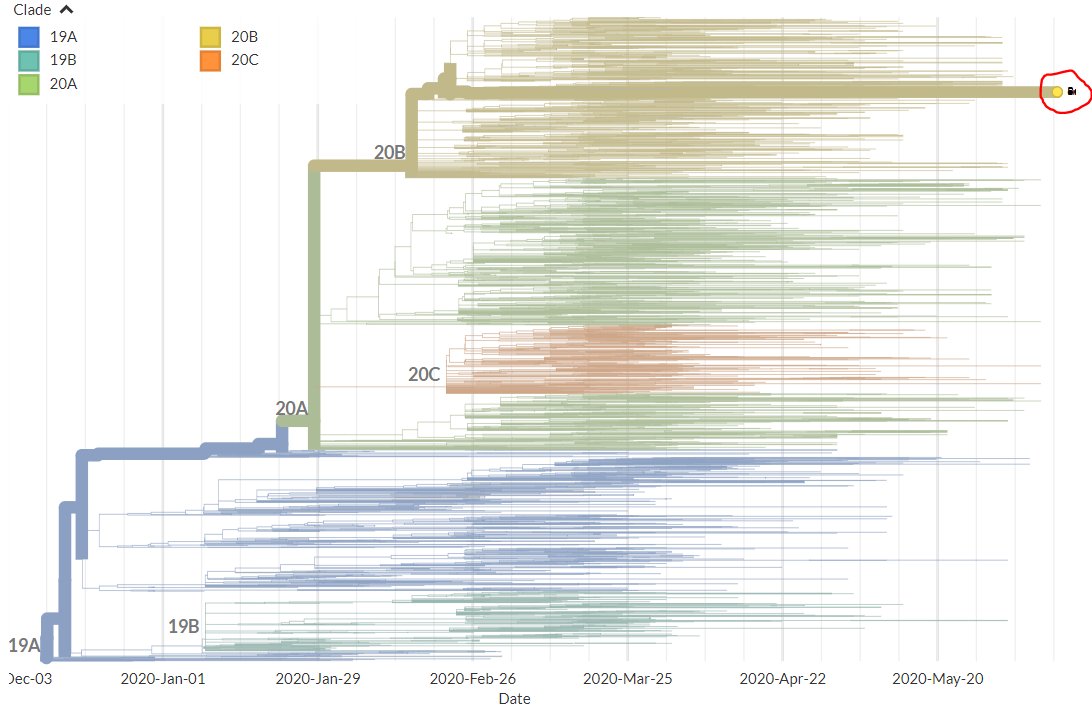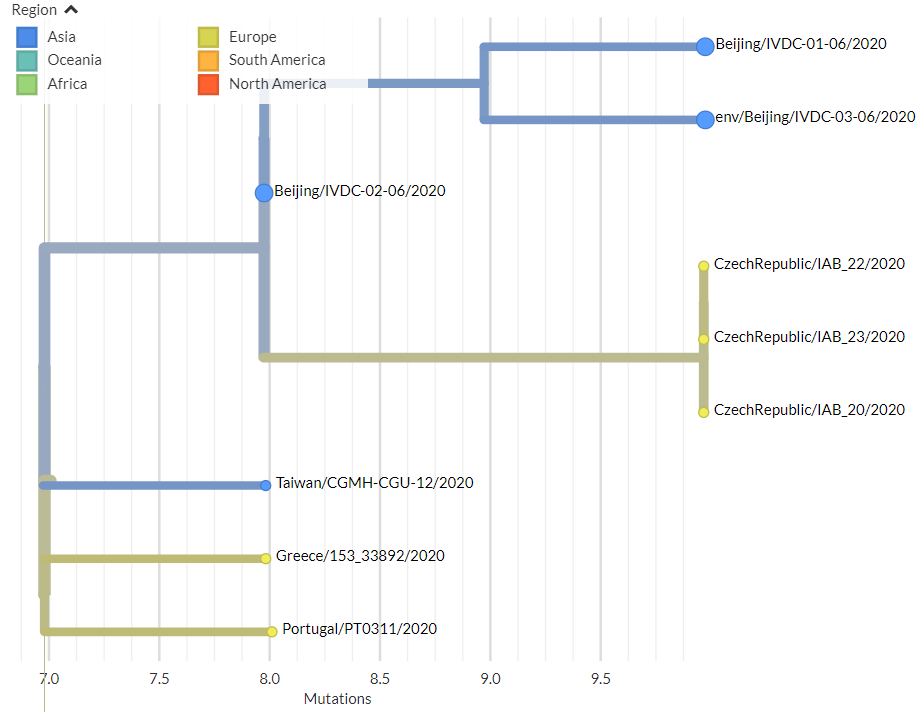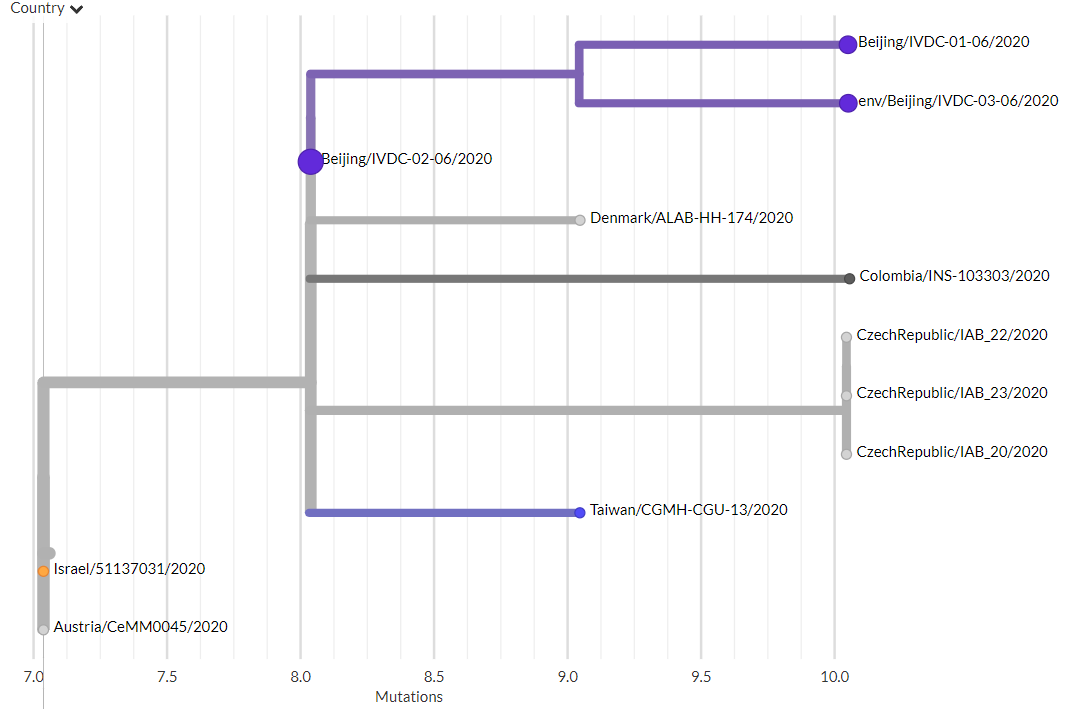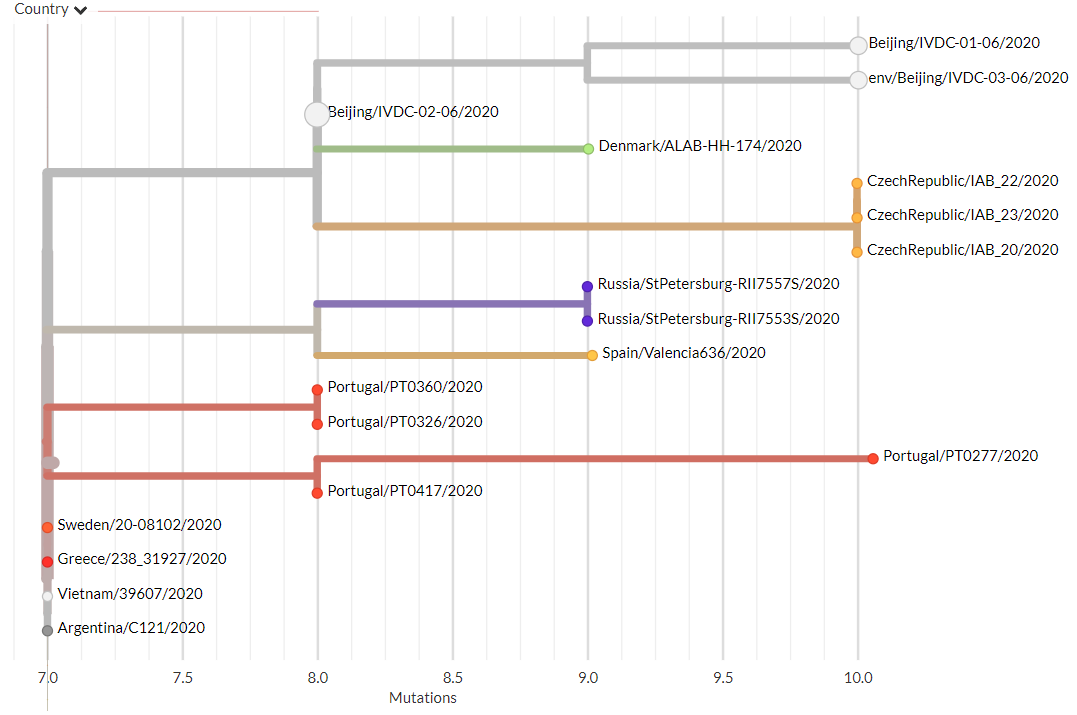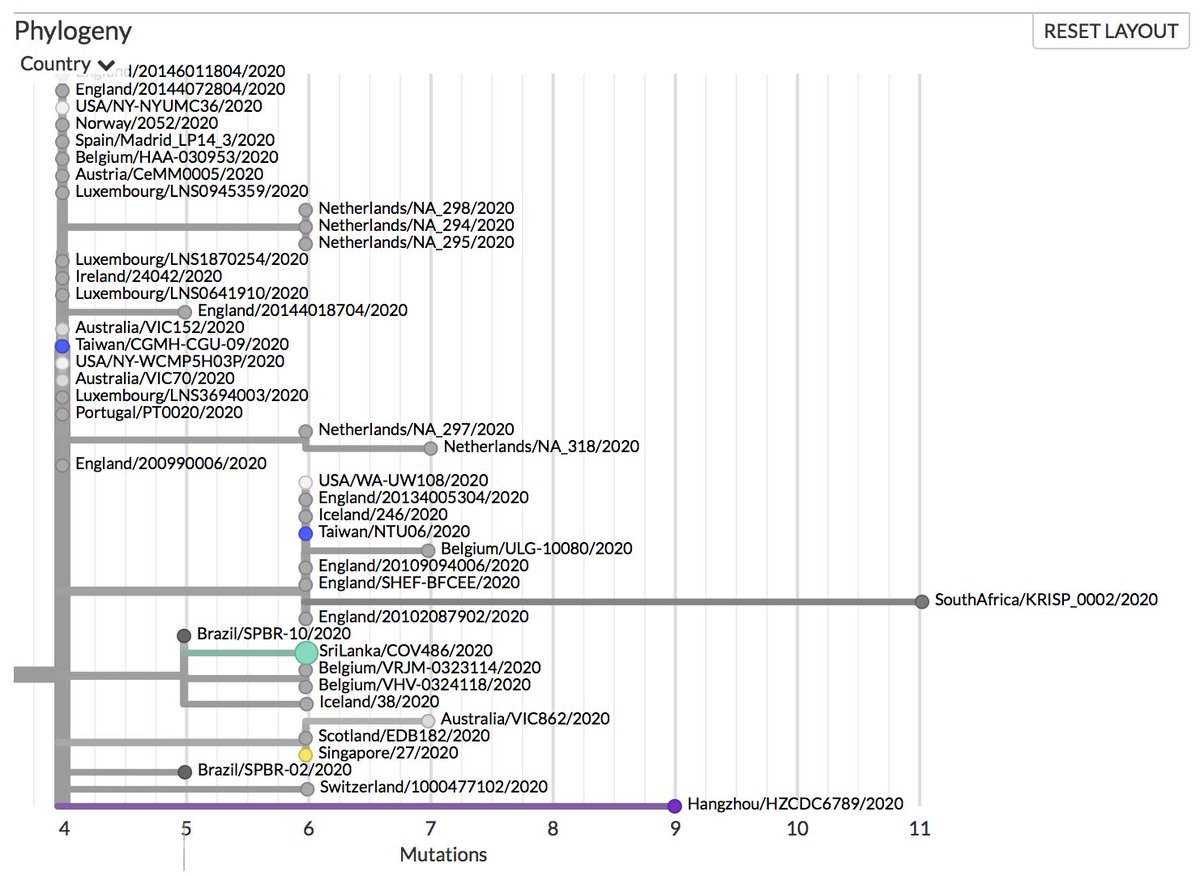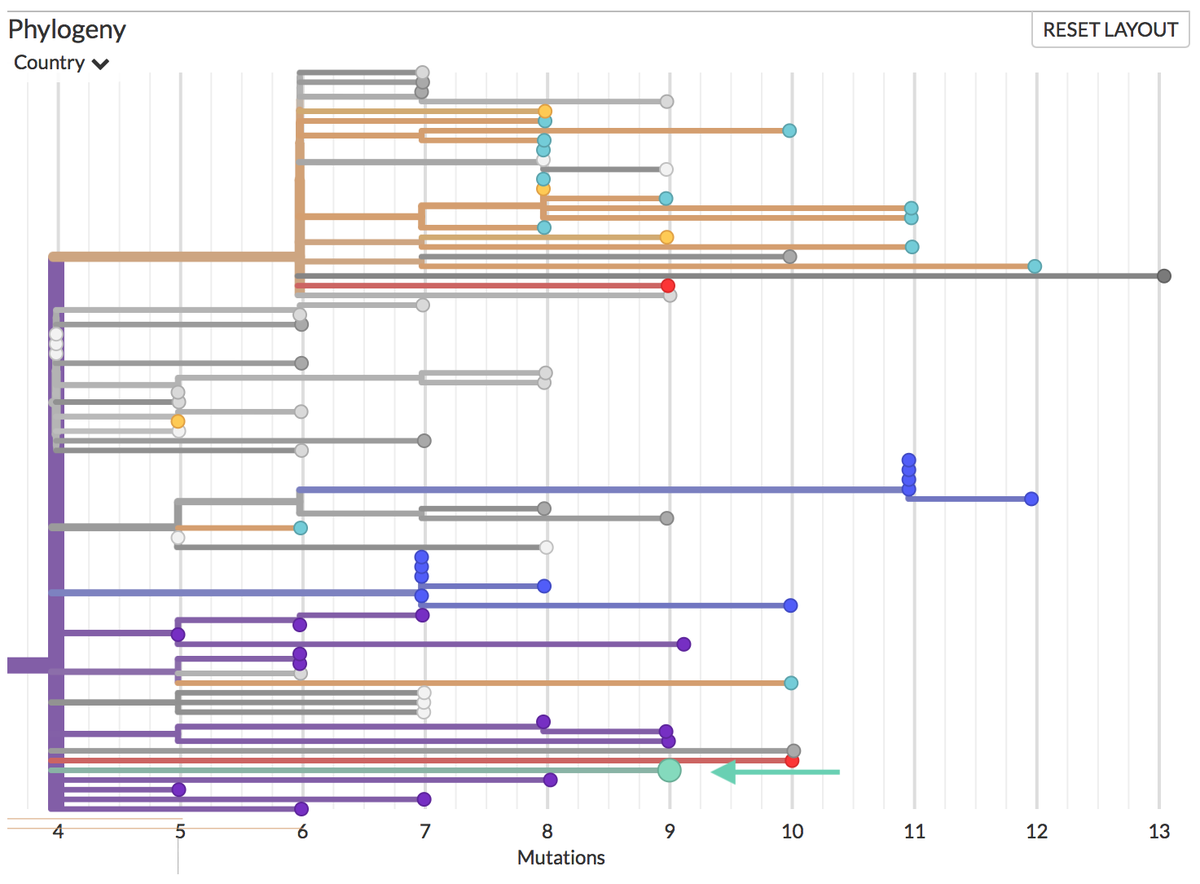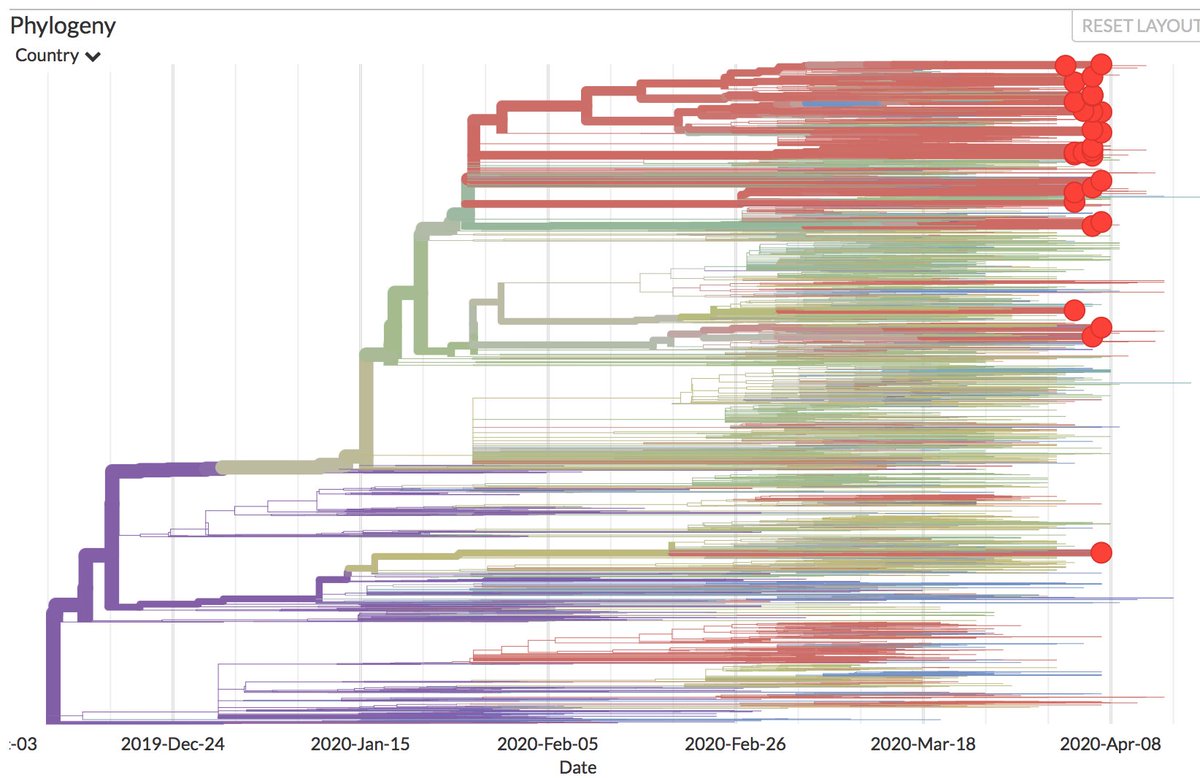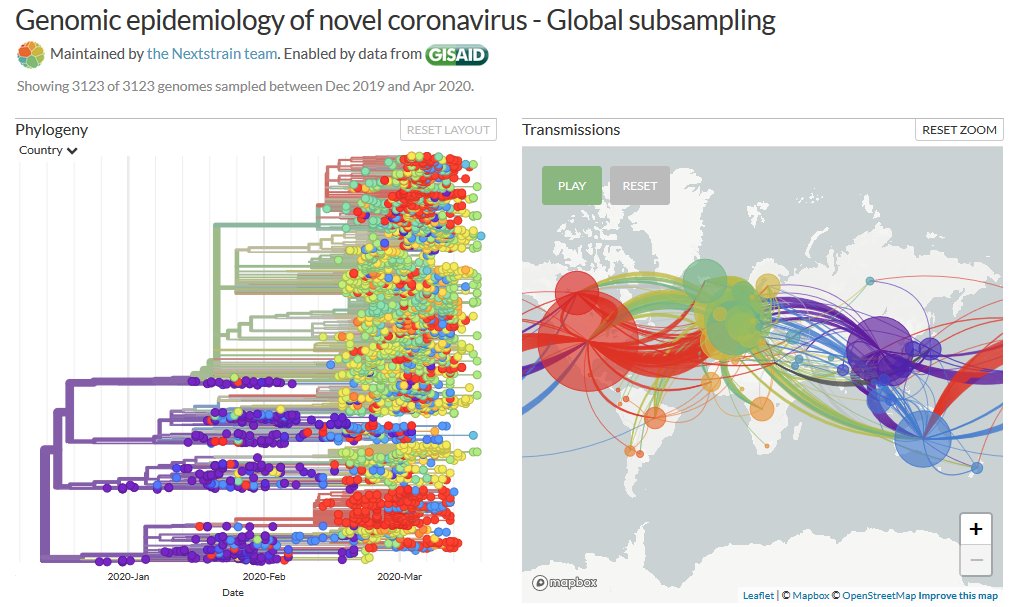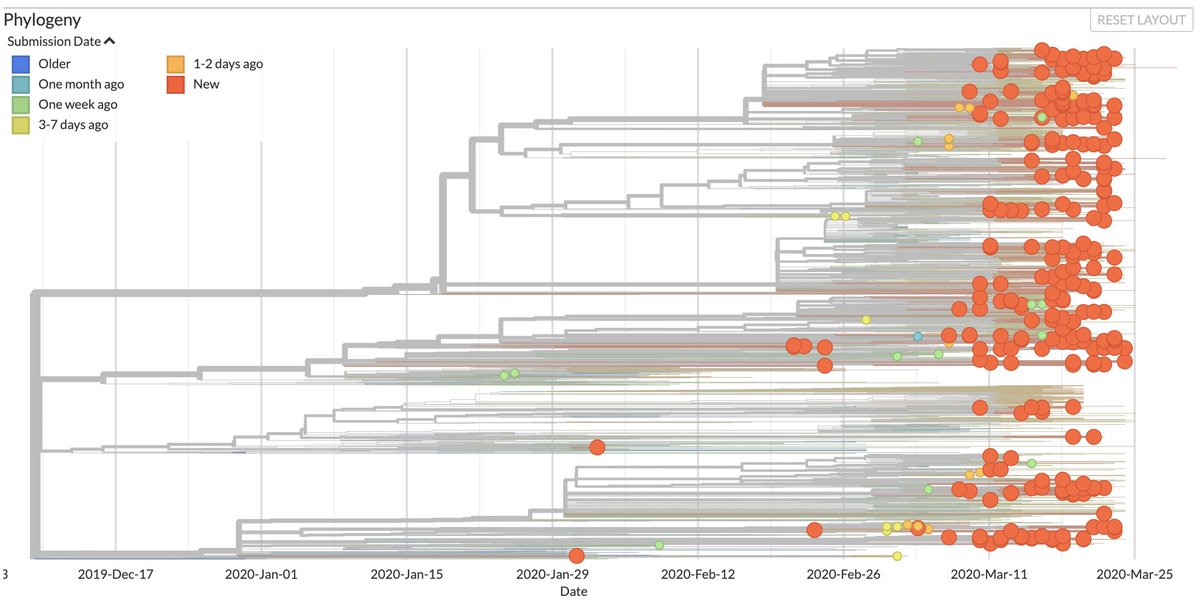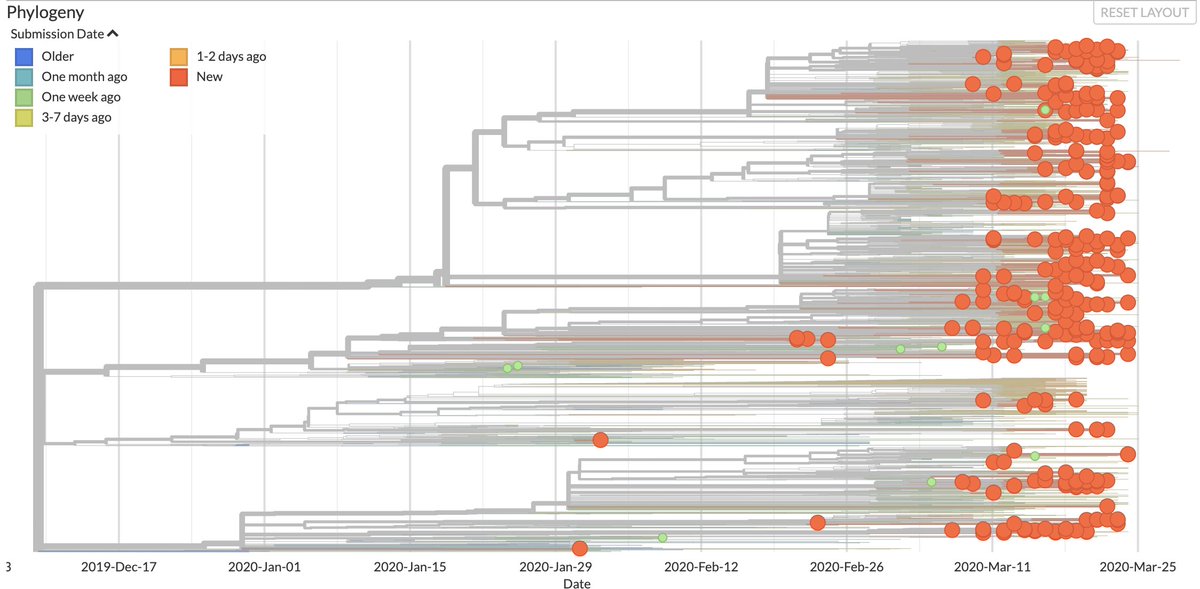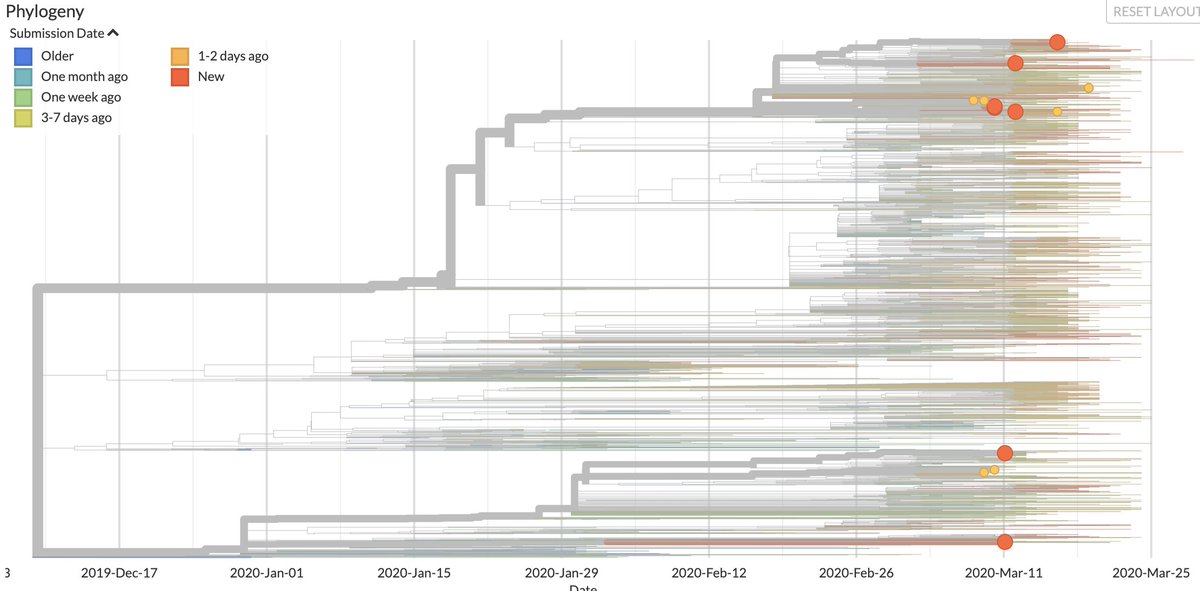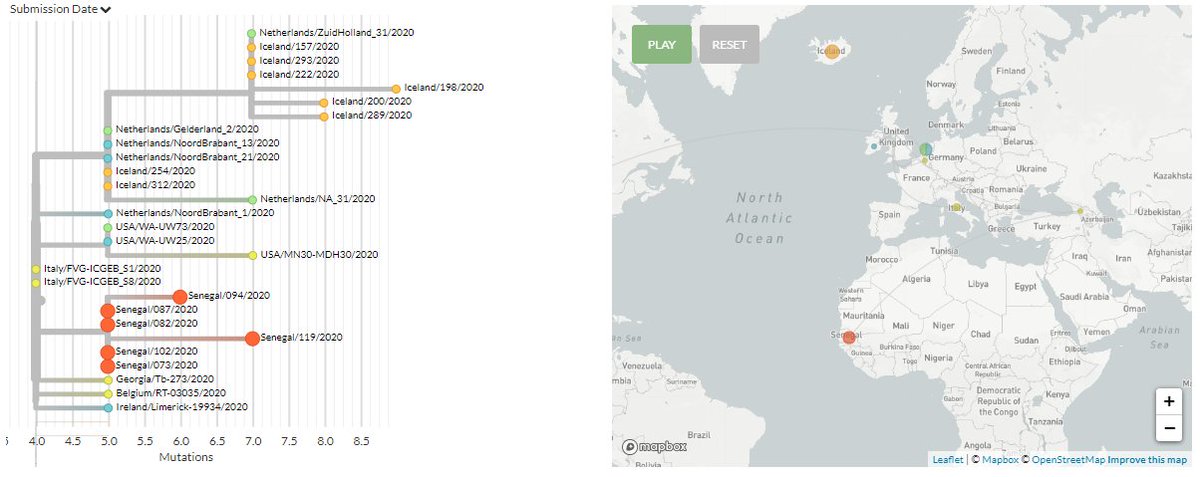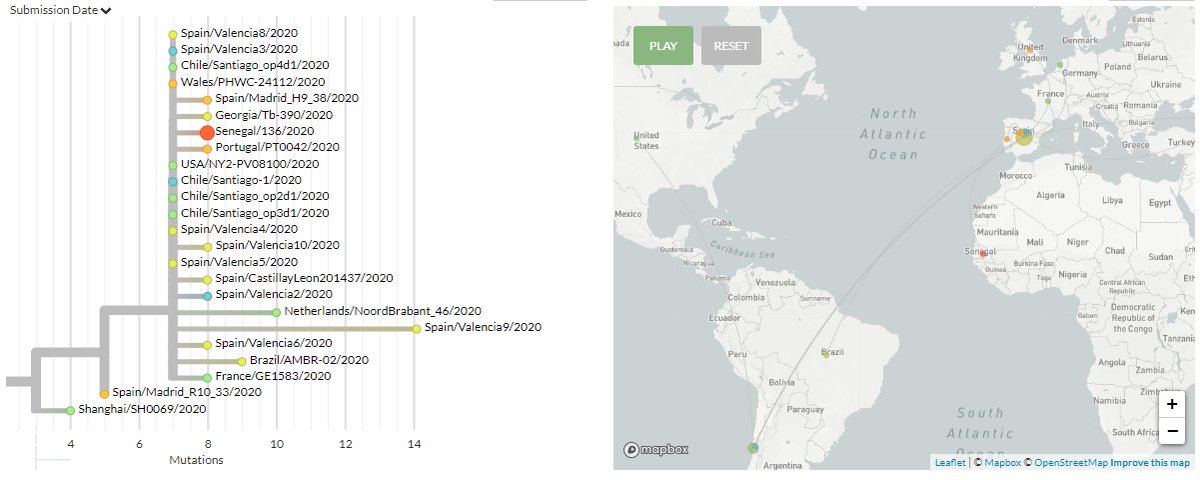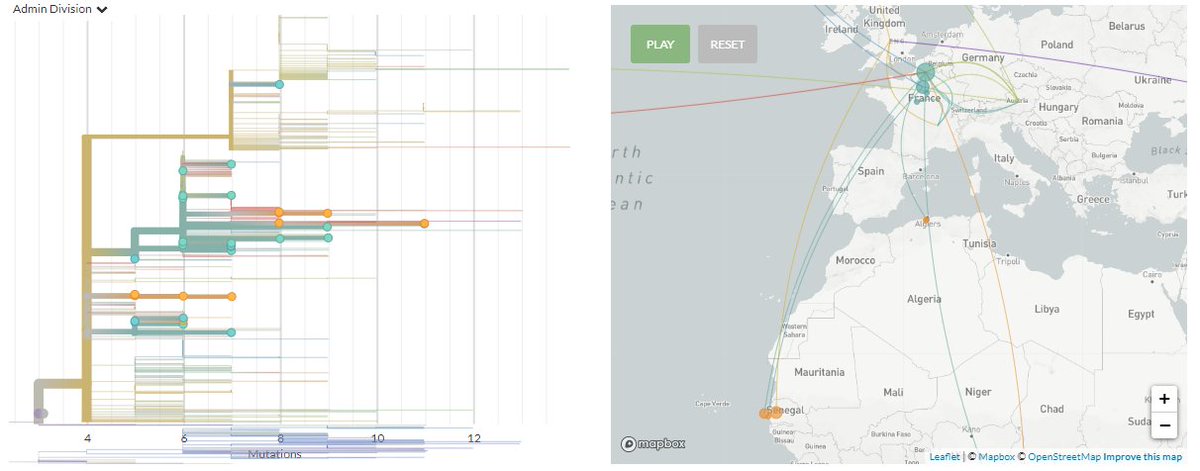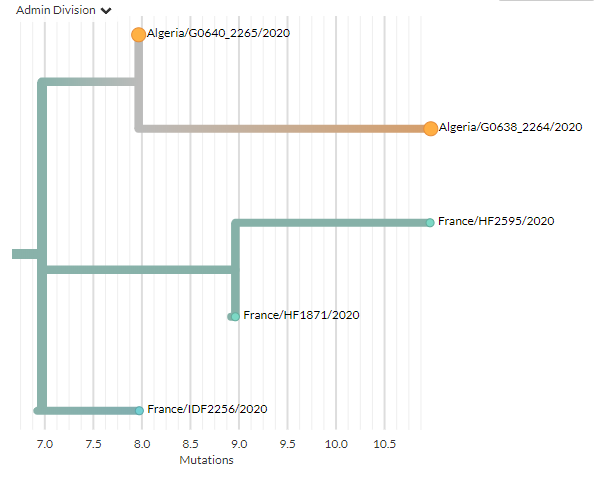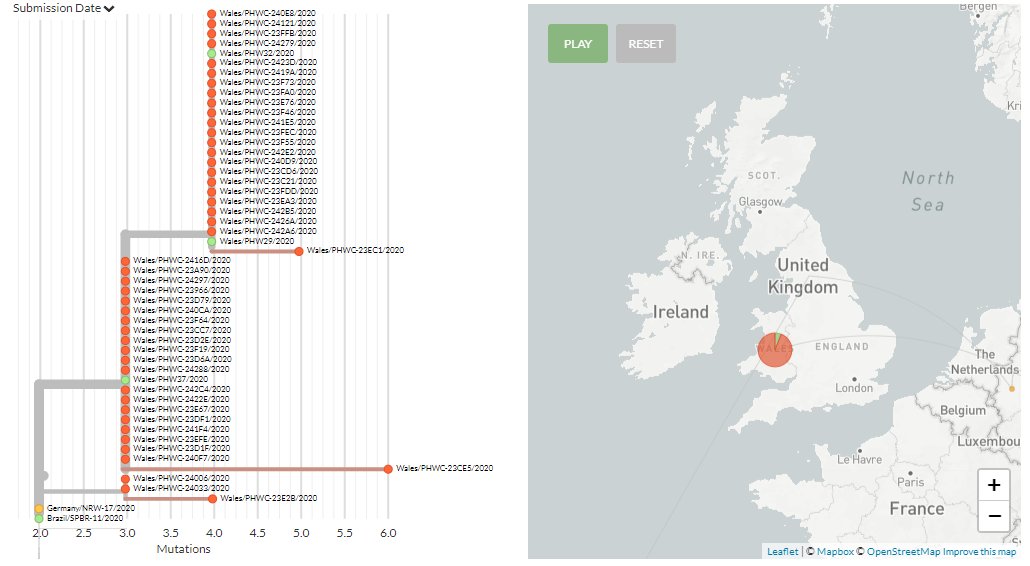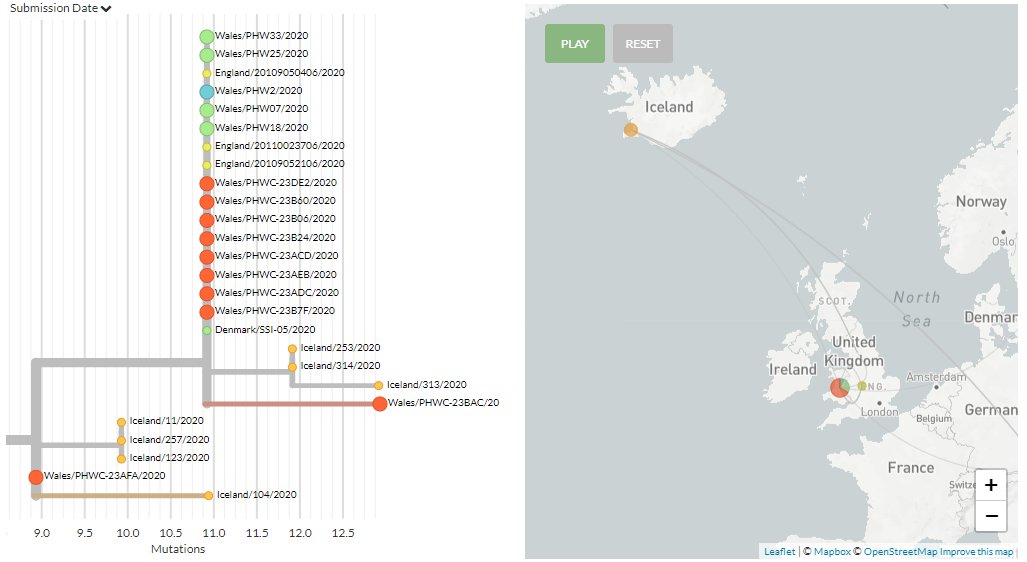
Thanks to #opendata sharing by @GISAID, we've updated nextstrain.org/ncov with 7236 new #COVID19 #SARSCoV2 sequences!
Check out the new sequences from Rwanda (1) on nextstrain.org/ncov/africa.
(Thanks to @RBCRwanda, @EMukantwali, @UmJeann)
1/11
Check out the new sequences from Rwanda (1) on nextstrain.org/ncov/africa.
(Thanks to @RBCRwanda, @EMukantwali, @UmJeann)
1/11

@GISAID @RBCRwanda @EMukantwali @UmJeann You can find the new sequences from Australia (6) and New Zealand (20) on nextstrain.org/ncov/oceania.
(Thanks to @SAHealth, @ESRNewZealand, @MathStorey, @Joepdl, @sciolato)
2/11
(Thanks to @SAHealth, @ESRNewZealand, @MathStorey, @Joepdl, @sciolato)
2/11

@GISAID @RBCRwanda @EMukantwali @UmJeann @SAHealth @ESRNewZealand @MathStorey @Joepdl @sciolato New sequences from Brazil (20), Chile (8), Trinidad (8) and Uruguay (1) can be found on nextstrain.org/ncov/south-ame….
(Thanks to @imtspusp, @saorafaelbahia, Instituto Adolfo Lutz, @ispch, @CMMUChile, @for_genome, @CVFCarrington, @UWI_StAugustine, @IPMontevideo)
3/11
(Thanks to @imtspusp, @saorafaelbahia, Instituto Adolfo Lutz, @ispch, @CMMUChile, @for_genome, @CVFCarrington, @UWI_StAugustine, @IPMontevideo)
3/11
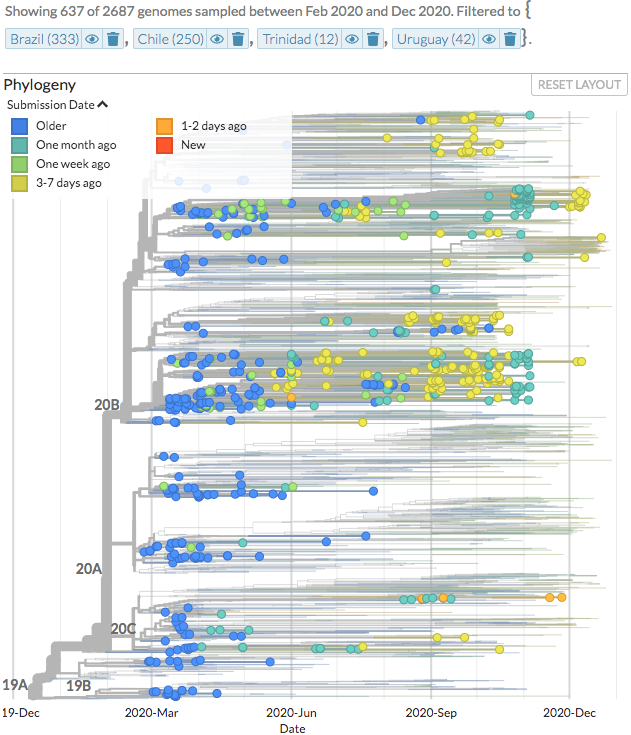
@GISAID @RBCRwanda @EMukantwali @UmJeann @SAHealth @ESRNewZealand @MathStorey @Joepdl @sciolato @imtspusp @saorafaelbahia @ispch @CMMUChile @for_genome @CVFCarrington @UWI_StAugustine @IPMontevideo New sequences from Bangladesh (10), Georgia (3), India (1), & Indonesia (12) are on nextstrain.org/ncov/asia.
(Thanks to @UnivofDhaka, @NCDCGeorgia, @THSTIFaridaba, @itbofficial, @sithitb, @unpad, Lab Kesehatan Jawa Barat, @11MaretUniv, @rumahsakituns, NIHRD Indonesia)
4/11
(Thanks to @UnivofDhaka, @NCDCGeorgia, @THSTIFaridaba, @itbofficial, @sithitb, @unpad, Lab Kesehatan Jawa Barat, @11MaretUniv, @rumahsakituns, NIHRD Indonesia)
4/11

@GISAID @RBCRwanda @EMukantwali @UmJeann @SAHealth @ESRNewZealand @MathStorey @Joepdl @sciolato @imtspusp @saorafaelbahia @ispch @CMMUChile @for_genome @CVFCarrington @UWI_StAugustine @IPMontevideo @UnivofDhaka @NCDCGeorgia @itbofficial @sithitb @unpad @11MaretUniv @rumahsakituns Seqs from Jordan (59), Nepal (14), Pakistan (2), Palestine (1), Singapore (35) & Thailand (3) on nextstrain.org/ncov/asia.
(Thanks @K_G_Andersen, @DrIssaAbuDayyeh, @scrippsresearch, NHRC Nepal, @NIH_Pakistan, Al-Quds University, NCID NPHL Singapore, @thailandnih, @pr_moph)
5/11
(Thanks @K_G_Andersen, @DrIssaAbuDayyeh, @scrippsresearch, NHRC Nepal, @NIH_Pakistan, Al-Quds University, NCID NPHL Singapore, @thailandnih, @pr_moph)
5/11

@GISAID @RBCRwanda @EMukantwali @UmJeann @SAHealth @ESRNewZealand @MathStorey @Joepdl @sciolato @imtspusp @saorafaelbahia @ispch @CMMUChile @for_genome @CVFCarrington @UWI_StAugustine @IPMontevideo @UnivofDhaka @NCDCGeorgia @itbofficial @sithitb @unpad @11MaretUniv @rumahsakituns @K_G_Andersen @DrIssaAbuDayyeh @scrippsresearch @NIH_Pakistan @thailandnih @pr_moph New sequences from Belarus (7), Denmark (2306), Finland (405), & France (51) are on nextstrain.org/ncov/europe.
(Thanks to WHO National Influenza Centre Russia, @MadsAlbertsen85, @kirk3gaard, @helsinkiuni @TimoSmura, @institutpasteur, @CHUdeToulouse)
6/11
(Thanks to WHO National Influenza Centre Russia, @MadsAlbertsen85, @kirk3gaard, @helsinkiuni @TimoSmura, @institutpasteur, @CHUdeToulouse)
6/11

@GISAID @RBCRwanda @EMukantwali @UmJeann @SAHealth @ESRNewZealand @MathStorey @Joepdl @sciolato @imtspusp @saorafaelbahia @ispch @CMMUChile @for_genome @CVFCarrington @UWI_StAugustine @IPMontevideo @UnivofDhaka @NCDCGeorgia @itbofficial @sithitb @unpad @11MaretUniv @rumahsakituns @K_G_Andersen @DrIssaAbuDayyeh @scrippsresearch @NIH_Pakistan @thailandnih @pr_moph @MadsAlbertsen85 @kirk3gaard @helsinkiuni @TimoSmura @institutpasteur @CHUdeToulouse Seqs from Germany (371), Italy (3), Luxembourg (1), Poland (12), & Portugal (19) on nextstrain.org/ncov/europe
(Thanks @ChariteBerlin, Bundeswehr Institute of Microbiology, CAST @univUda, @LNS_Lux, @genXone_SA, @UniWarszawski, @borges__vitor, @raqguiomar, @GOMES__JP, @irj_pt)
7/11
(Thanks @ChariteBerlin, Bundeswehr Institute of Microbiology, CAST @univUda, @LNS_Lux, @genXone_SA, @UniWarszawski, @borges__vitor, @raqguiomar, @GOMES__JP, @irj_pt)
7/11

@GISAID @RBCRwanda @EMukantwali @UmJeann @SAHealth @ESRNewZealand @MathStorey @Joepdl @sciolato @imtspusp @saorafaelbahia @ispch @CMMUChile @for_genome @CVFCarrington @UWI_StAugustine @IPMontevideo @UnivofDhaka @NCDCGeorgia @itbofficial @sithitb @unpad @11MaretUniv @rumahsakituns @K_G_Andersen @DrIssaAbuDayyeh @scrippsresearch @NIH_Pakistan @thailandnih @pr_moph @MadsAlbertsen85 @kirk3gaard @helsinkiuni @TimoSmura @institutpasteur @CHUdeToulouse @ChariteBerlin @univUda @LNS_Lux @genXone_SA @UniWarszawski @borges__vitor @raqguiomar @GOMES__JP @irj_pt New sequences from Romania (1), Russia (19), Spain (3) and the United Kingdom (1081) are on nextstrain.org/ncov/europe.
(Thanks to Cantacuzino Institute, CRIE Russia, Hospital General Universitario Gregorio Marañón, @CovidGenomicsUK)
8/11
(Thanks to Cantacuzino Institute, CRIE Russia, Hospital General Universitario Gregorio Marañón, @CovidGenomicsUK)
8/11

@GISAID @RBCRwanda @EMukantwali @UmJeann @SAHealth @ESRNewZealand @MathStorey @Joepdl @sciolato @imtspusp @saorafaelbahia @ispch @CMMUChile @for_genome @CVFCarrington @UWI_StAugustine @IPMontevideo @UnivofDhaka @NCDCGeorgia @itbofficial @sithitb @unpad @11MaretUniv @rumahsakituns @K_G_Andersen @DrIssaAbuDayyeh @scrippsresearch @NIH_Pakistan @thailandnih @pr_moph @MadsAlbertsen85 @kirk3gaard @helsinkiuni @TimoSmura @institutpasteur @CHUdeToulouse @ChariteBerlin @univUda @LNS_Lux @genXone_SA @UniWarszawski @borges__vitor @raqguiomar @GOMES__JP @irj_pt @CovidGenomicsUK New sequences from Antigua and Barbuda (1), Jamaica (5), Saint Kitts and Nevis (3), Saint Vincent and the Grenadines (1), & Canada (284) are on nextstrain.org/ncov/north-ame….
(Thanks to @CVFCarrington @UWI_StAugustine, @McMasterU, @TIBDN)
9/11
(Thanks to @CVFCarrington @UWI_StAugustine, @McMasterU, @TIBDN)
9/11

@GISAID @RBCRwanda @EMukantwali @UmJeann @SAHealth @ESRNewZealand @MathStorey @Joepdl @sciolato @imtspusp @saorafaelbahia @ispch @CMMUChile @for_genome @CVFCarrington @UWI_StAugustine @IPMontevideo @UnivofDhaka @NCDCGeorgia @itbofficial @sithitb @unpad @11MaretUniv @rumahsakituns @K_G_Andersen @DrIssaAbuDayyeh @scrippsresearch @NIH_Pakistan @thailandnih @pr_moph @MadsAlbertsen85 @kirk3gaard @helsinkiuni @TimoSmura @institutpasteur @CHUdeToulouse Seqs from the USA (2459) on nextstrain.org/ncov/north-ame….
(Thanks to @CDCgov, CPM @ChildrensLA, @CAPublicHealth, @igisci, @UCBerkeley, @lapublichealth, @K_G_Andersen, @scrippsresearch, @NathanGrubaugh, @JosephFauver, @YaleSPH, @AnnePiantadosi @Ahmed_HBabiker @EmoryPathology)
10/11
(Thanks to @CDCgov, CPM @ChildrensLA, @CAPublicHealth, @igisci, @UCBerkeley, @lapublichealth, @K_G_Andersen, @scrippsresearch, @NathanGrubaugh, @JosephFauver, @YaleSPH, @AnnePiantadosi @Ahmed_HBabiker @EmoryPathology)
10/11

@GISAID @RBCRwanda @EMukantwali @UmJeann @SAHealth @ESRNewZealand @MathStorey @Joepdl @sciolato @imtspusp @saorafaelbahia @ispch @CMMUChile @for_genome @CVFCarrington @UWI_StAugustine @IPMontevideo @UnivofDhaka @NCDCGeorgia @itbofficial @sithitb @unpad @11MaretUniv @rumahsakituns @K_G_Andersen @DrIssaAbuDayyeh @scrippsresearch @NIH_Pakistan @thailandnih @pr_moph @MadsAlbertsen85 @kirk3gaard @helsinkiuni USA seqs also thanks to @HawaiiDOH, @KATarinambraun, @GageKMoreno, @tcflab, @dho_lab, @HealthNYGov, @UtahDepOfHealth, @Dr_KFO, @erinYoun, @microbemagic1, @cychiu98, @UofCalifornia, @jacksonlab, @CreightonSOM, @UWVirology, @UW, @pavitrarc
11/11
11/11
• • •
Missing some Tweet in this thread? You can try to
force a refresh

